Tuesday, October 04, 2005
A Family Reunion
The Cardinal Flyers Online is the premier organization for owners and fans of the Cessna Cardinal. They host regular regional flyins as well as a national convention. This year's Northeast flyin was held in Lancaster, PA. The original Schedule was for August 20th, but poor weather forced a postponement to the next weekend. This was the first CFO event that Yellowbird and I have been able to attend, so we were excited at the prospect of meeting up to 90 of her siblings. As things turned out, the reschedule and some iffy weather kept the turnout to around 45 Cardinals, but we still had a great time.
I addition to an enjoyable family reunion, the trip to Lancaster was notable in a few ways: it was the longest cross-country venture we have taken so far, and we set new personal record for cruising altitude and groundspeed. I managed to get photos of about 30 of the Cardinals, and they represent a thorough sample of Cardinal development. It's taken a while to catalog and document the pictures, but I hope you will enjoy this extensive family portrait.
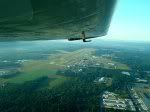 Departing Westfield at 7:00 on a clear Saturday morning. Arrivals were already underway for the weekend's airshow and the south end of the field was covered with static displays and performers. The pattern was busy from the minute the tower opened, and I got to hold short for a P-51 that was trying to fit in with the slower traffic. Once aloft, we had smooth sailing through to eastern New York.
Departing Westfield at 7:00 on a clear Saturday morning. Arrivals were already underway for the weekend's airshow and the south end of the field was covered with static displays and performers. The pattern was busy from the minute the tower opened, and I got to hold short for a P-51 that was trying to fit in with the slower traffic. Once aloft, we had smooth sailing through to eastern New York.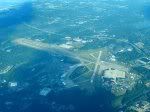 Just over the Hudson River, Stewart International rests quietly under partly cloudy skies. A flock of C-5 Galaxies roost on the ANG ramp at lower right.
Just over the Hudson River, Stewart International rests quietly under partly cloudy skies. A flock of C-5 Galaxies roost on the ANG ramp at lower right.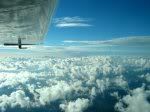 As we made our way southwest, the clouds increased. From 8,500 feet, the scattered layer presented a scenic cloudscape.
As we made our way southwest, the clouds increased. From 8,500 feet, the scattered layer presented a scenic cloudscape.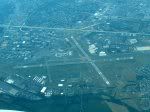 Further on our journey, Lehigh Valley conducted a few morning flights. I listened in as I passed overhead, about 4,000 feet above the top of the class Charlie airspace.
Further on our journey, Lehigh Valley conducted a few morning flights. I listened in as I passed overhead, about 4,000 feet above the top of the class Charlie airspace.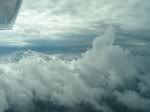 From then on, the clouds grew thicker and more abundant. Descending towards Lancaster, I had to divert around a few areas of broken coverage. Skies like this give a heightened sense of motion as you fly though them, at a cost of increased vigilance.
From then on, the clouds grew thicker and more abundant. Descending towards Lancaster, I had to divert around a few areas of broken coverage. Skies like this give a heightened sense of motion as you fly though them, at a cost of increased vigilance.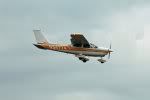 With about two hours on the clock, we arrived at Lancaster, to be recorded by the official CFO photographer. I have very few inflight pictures of Yellowbird. This one is already my favorite.
With about two hours on the clock, we arrived at Lancaster, to be recorded by the official CFO photographer. I have very few inflight pictures of Yellowbird. This one is already my favorite.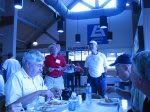 As the Cardinals gathered, there was much socializing. Introductions were made, and old friends welcomed. Each arrival was greeted with a red carpet and a bag of goodies assembled by the hosts. By 12:00 we had a good crowd, and it was time to head into the terminal for lunch. As we ate, hosts Al and Norm gave the opening address and various recognitions were made. Somewhere in Cardinal Land, there's a CFO member with a picture of me taking this picture. I hope he had his exposure set correctly.
As the Cardinals gathered, there was much socializing. Introductions were made, and old friends welcomed. Each arrival was greeted with a red carpet and a bag of goodies assembled by the hosts. By 12:00 we had a good crowd, and it was time to head into the terminal for lunch. As we ate, hosts Al and Norm gave the opening address and various recognitions were made. Somewhere in Cardinal Land, there's a CFO member with a picture of me taking this picture. I hope he had his exposure set correctly.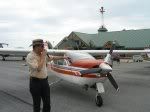 After lunch, we headed out to the ramp to enjoy our birds. CFO webmaster Keith Peterson conducted his traditional inspections, picking a random Cardinal from the roost and pointing out any unusual features. Not only could his seasoned eye spot a nonstandard rivet at ten paces, but he could also tell you why it was there and what the mechanic who drove it had for breakfast. Here he contemplates the nuances of Sal's propeller.
After lunch, we headed out to the ramp to enjoy our birds. CFO webmaster Keith Peterson conducted his traditional inspections, picking a random Cardinal from the roost and pointing out any unusual features. Not only could his seasoned eye spot a nonstandard rivet at ten paces, but he could also tell you why it was there and what the mechanic who drove it had for breakfast. Here he contemplates the nuances of Sal's propeller.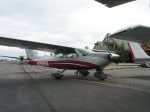 Although turnout was less than registration, we still had a fairly complete representation of the Cardinal family lineage. From the early days, we have a 1968 model, updated with a very striking custom paint job and a few aerodynamic refinements.
Although turnout was less than registration, we still had a fairly complete representation of the Cardinal family lineage. From the early days, we have a 1968 model, updated with a very striking custom paint job and a few aerodynamic refinements.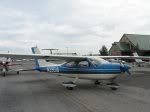 Here's another 1968 model, wearing a faded version of the 1969 livery. This Cardinal is a work in progress: the interior has been thoroughly restored to original condition, and the exterior is next on the list.
Here's another 1968 model, wearing a faded version of the 1969 livery. This Cardinal is a work in progress: the interior has been thoroughly restored to original condition, and the exterior is next on the list. The face of an early Cardinal. From head-on, the oddly shaped intakes are readily apparent. The side intakes provide cooling air for the engine, while the intake below the propeller provides filtered air for the carburetor. These intakes were unlike anything previously seen on Cessna aircraft, and must have contributed significantly, by 1968 standards to the Cardinal's radical new look.
The face of an early Cardinal. From head-on, the oddly shaped intakes are readily apparent. The side intakes provide cooling air for the engine, while the intake below the propeller provides filtered air for the carburetor. These intakes were unlike anything previously seen on Cessna aircraft, and must have contributed significantly, by 1968 standards to the Cardinal's radical new look.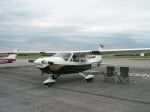 This 1969 Cardinal has been completely reworked, inside and out. The 1969 model introduced a more powerful engine and relocated the carburetor intake, but kept the fixed pitch propeller seen on the 1968 Cardinals. Other features were also retained, including the sharper wing leading edge and the rather archaic looking wheel pants.
This 1969 Cardinal has been completely reworked, inside and out. The 1969 model introduced a more powerful engine and relocated the carburetor intake, but kept the fixed pitch propeller seen on the 1968 Cardinals. Other features were also retained, including the sharper wing leading edge and the rather archaic looking wheel pants.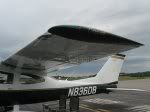 A wingtip view show the sharp leading edge to good effect. The dual landing/taxi lights on early Cardinal were located in the left wing. Later Cardinals carry them in the nose. This Cardinal has a fixed, ground-adjustable rudder trim tab, similar to those seen on Skyhawks.
A wingtip view show the sharp leading edge to good effect. The dual landing/taxi lights on early Cardinal were located in the left wing. Later Cardinals carry them in the nose. This Cardinal has a fixed, ground-adjustable rudder trim tab, similar to those seen on Skyhawks. Stall strips were a feature added to the wings of the 1968 and 1969 Cardinals in order to provide better control during this stall. The vortex generator vanes seen atop the wing accomplish the same effect via different means.
Stall strips were a feature added to the wings of the 1968 and 1969 Cardinals in order to provide better control during this stall. The vortex generator vanes seen atop the wing accomplish the same effect via different means.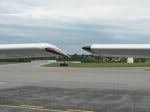 The early (right) and late (left) wings in comparison. A close look shows the blunter leading edge of the late wing, which was introduced on the 177B models. The 177B wingtip is also distinguished by a distinct downturn at the tip, as seen here.
The early (right) and late (left) wings in comparison. A close look shows the blunter leading edge of the late wing, which was introduced on the 177B models. The 177B wingtip is also distinguished by a distinct downturn at the tip, as seen here. This 1970 177B shows off its unique custom paint job. The B model wing is evident, as are some early features such as wing-mounted landing lights, early-style wheel pants, and the larger air intakes.
This 1970 177B shows off its unique custom paint job. The B model wing is evident, as are some early features such as wing-mounted landing lights, early-style wheel pants, and the larger air intakes.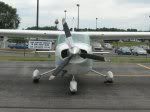 The 177B also introduced adjustable cowl flaps under the nose to regulate the flow of cooling air through the engine compartment, and a constant speed propeller. This Cardinal carries an aftermarket three blade propeller - a common upgrade.
The 177B also introduced adjustable cowl flaps under the nose to regulate the flow of cooling air through the engine compartment, and a constant speed propeller. This Cardinal carries an aftermarket three blade propeller - a common upgrade.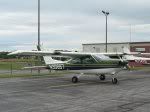 There must have been some flexibility in the application of paint schemes between the consecutive model years, as this 1970 Cardinal carries the same 1969 pattern as the 1968 seen earlier. This Cardinal also flies pantsless, something commonly seen during the winter months, when snow and slush threaten to freeze inside the wheel fairings.
There must have been some flexibility in the application of paint schemes between the consecutive model years, as this 1970 Cardinal carries the same 1969 pattern as the 1968 seen earlier. This Cardinal also flies pantsless, something commonly seen during the winter months, when snow and slush threaten to freeze inside the wheel fairings.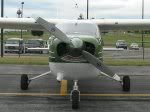 A front view shows the constant speed propeller and carburetor intake in the left air intake, as well as the Cessna decal in the blank space that it formerly occupied. The faring around the exhaust pipe is an aftermarket upgrade which improves engine cooling. It also looks much nicer than a bare tailpipe.
A front view shows the constant speed propeller and carburetor intake in the left air intake, as well as the Cessna decal in the blank space that it formerly occupied. The faring around the exhaust pipe is an aftermarket upgrade which improves engine cooling. It also looks much nicer than a bare tailpipe.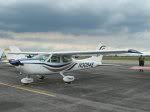 This 1971 model also has the tailpipe faring, as well as the late-style wheel pants seen on 1975 and later Cardinals. Barely visible is the nose mounted landing light, which was introduced with this model.
This 1971 model also has the tailpipe faring, as well as the late-style wheel pants seen on 1975 and later Cardinals. Barely visible is the nose mounted landing light, which was introduced with this model. The mid-style wheel pants are seen on this 1972 Cardinal, along with an attractive custom paint scheme.
The mid-style wheel pants are seen on this 1972 Cardinal, along with an attractive custom paint scheme.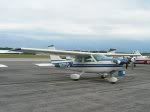 A 1973 Cardinal, with an appropriately customized registration number. N177RG is carried, deservedly so, by a 177RG, but N177 is registered to a Piper Apache, N177A to a 177B Cardinal, and N177B to a Bell helicopter. Late-style wheel pants and an exhaust fairing are carried as well, and the custom paint job appears to borrow elements from several factory Cardinal patterns.
A 1973 Cardinal, with an appropriately customized registration number. N177RG is carried, deservedly so, by a 177RG, but N177 is registered to a Piper Apache, N177A to a 177B Cardinal, and N177B to a Bell helicopter. Late-style wheel pants and an exhaust fairing are carried as well, and the custom paint job appears to borrow elements from several factory Cardinal patterns. Preparing for departure, she shows of her custom paint. She also exhibits the fixed steps below the cabin doors. Many of the Cardinals in attendance had these removed.
Preparing for departure, she shows of her custom paint. She also exhibits the fixed steps below the cabin doors. Many of the Cardinals in attendance had these removed.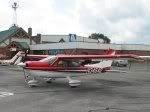 This very sharp looking 1973 Cardinal was the winner of the "Best Exterior" award, voted on by those in attendance. She carries a number of enhancements, including an exhaust fairing and wide-chord covers for the main landing gear struts. The paint is the original pattern for 1973, but I suspect that it has been recently reapplied. It would be truly remarkable for a 30 year old paint job to look this good!
This very sharp looking 1973 Cardinal was the winner of the "Best Exterior" award, voted on by those in attendance. She carries a number of enhancements, including an exhaust fairing and wide-chord covers for the main landing gear struts. The paint is the original pattern for 1973, but I suspect that it has been recently reapplied. It would be truly remarkable for a 30 year old paint job to look this good!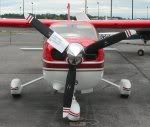 A front view reveals the late model air intakes introduced in 1973. These were much more traditional in relation to the intakes on other Cessna aircraft. The matching stripes on the aftermarket propeller and wheel pants are a classy touch.
A front view reveals the late model air intakes introduced in 1973. These were much more traditional in relation to the intakes on other Cessna aircraft. The matching stripes on the aftermarket propeller and wheel pants are a classy touch.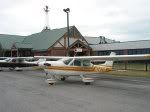 I'm going to start a collection of aerodrome beacon photos. The Lancaster beacon has a nice classic look, but this shot has a couple of airplanes in the way.
I'm going to start a collection of aerodrome beacon photos. The Lancaster beacon has a nice classic look, but this shot has a couple of airplanes in the way.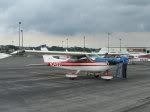 There were a few 1974 Cardinals in attendance, including some with their original paint. This one carries the 1975 scheme with patriotic colors.
There were a few 1974 Cardinals in attendance, including some with their original paint. This one carries the 1975 scheme with patriotic colors.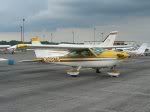 A true 1975 177B, with the Cardinal II designation. The late-style wheel pants were standard with this year.
A true 1975 177B, with the Cardinal II designation. The late-style wheel pants were standard with this year.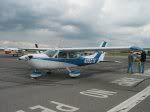 Another 1975 model, with custom paint and an exhaust faring. The black material on the stabilator leading edge is a rubber abrasion boot used to limit the damage caused by rocks and other loose debris stirred up by the propeller. These were an option introduced in 1974, but not too many Cardinals carry them.
Another 1975 model, with custom paint and an exhaust faring. The black material on the stabilator leading edge is a rubber abrasion boot used to limit the damage caused by rocks and other loose debris stirred up by the propeller. These were an option introduced in 1974, but not too many Cardinals carry them.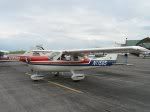 This is the standard 1976 livery, with a cardinal decal on the tail. I should get one of those for Yellowbird.
This is the standard 1976 livery, with a cardinal decal on the tail. I should get one of those for Yellowbird.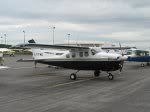 No, it's not Cardinal, but there is a genetic link. This Canadian P210N Centurion flies on a wing design which was later adapted for the Cardinal. This is our big brother, so to speak.
No, it's not Cardinal, but there is a genetic link. This Canadian P210N Centurion flies on a wing design which was later adapted for the Cardinal. This is our big brother, so to speak.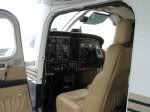 The innards of this big critter were as impressive as the outards and included an enviable collection of avionics.
The innards of this big critter were as impressive as the outards and included an enviable collection of avionics.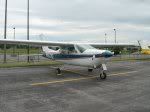 The retractable side of the family was well represented. Although the evolution of the RG line is not as visibly apparent as that of the FG's, there was plenty of variety among the folding leg set. This custom painted 72 RG was the only example present with the early style air intakes. With the RG version of these intakes, the landing lights were located below the propeller where the 68 FG's carburetor intake used to be.
The retractable side of the family was well represented. Although the evolution of the RG line is not as visibly apparent as that of the FG's, there was plenty of variety among the folding leg set. This custom painted 72 RG was the only example present with the early style air intakes. With the RG version of these intakes, the landing lights were located below the propeller where the 68 FG's carburetor intake used to be. Custom paint jobs were as popular with the RG 's as they were with the FG's. This 1974 RG wears what appears to be a variant of the 1978 FG paint scheme.
Custom paint jobs were as popular with the RG 's as they were with the FG's. This 1974 RG wears what appears to be a variant of the 1978 FG paint scheme.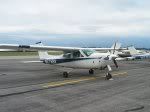 Another 1975 model in custom colors. The cardinal decal, usually placed on the tail, leads the way, towing a sizable swath of blue.
Another 1975 model in custom colors. The cardinal decal, usually placed on the tail, leads the way, towing a sizable swath of blue.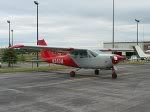 Yet another 1975 RG, with a striking, if somewhat utilitarian paint job. If the Air Force flew Cardinals in Antarctica, they would look like this.
Yet another 1975 RG, with a striking, if somewhat utilitarian paint job. If the Air Force flew Cardinals in Antarctica, they would look like this. A pretty 1976 Cardinal RG in original paint, with what appear to be imitation deicer boots on the wings. Cardinals are not certified for icing, so these may be painted strips to highlight any ice buildup before it becomes critical.
A pretty 1976 Cardinal RG in original paint, with what appear to be imitation deicer boots on the wings. Cardinals are not certified for icing, so these may be painted strips to highlight any ice buildup before it becomes critical.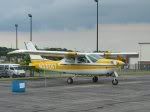 This very bright 1976 RG is the trusty steed of CFO webmaster Keith Peterson. If it looks familiar, it may be because it was used as the visual model for the DreamFleet Cardinal RG for Microsoft Flight Simulator.
This very bright 1976 RG is the trusty steed of CFO webmaster Keith Peterson. If it looks familiar, it may be because it was used as the visual model for the DreamFleet Cardinal RG for Microsoft Flight Simulator. This 1978 RG carries it's original paint, but with a very small registration number. FAA regulations specify that registration numbers are to be in letters at least 12 inches high, but there are exceptions.
This 1978 RG carries it's original paint, but with a very small registration number. FAA regulations specify that registration numbers are to be in letters at least 12 inches high, but there are exceptions.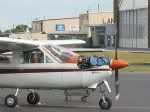 On lucky Cardinal was the recipient of a free propeller rebalancing, donated by Sensenich Propeller Service. I had Yellowbird's prop rebalanced back in June, but I haven't been inspired to blog a PIREP yet.
On lucky Cardinal was the recipient of a free propeller rebalancing, donated by Sensenich Propeller Service. I had Yellowbird's prop rebalanced back in June, but I haven't been inspired to blog a PIREP yet.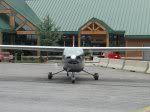 The Cardinal's appealing geometry is shown in this view of a 1968 FG warming up for departure. It was tough to leave, but with the weather looking more unsettled, it was time for us to depart as well.
The Cardinal's appealing geometry is shown in this view of a 1968 FG warming up for departure. It was tough to leave, but with the weather looking more unsettled, it was time for us to depart as well.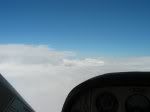 Skies were broken to overcast at various levels, but we found space sufficient to climb above most of the weather while still remaining in the clear. As we made our way northeastward, the lower cloud layer thickened, and we were faced with the choice of descending below it to run under the weather, or climbing above. We climbed, and Yellowbird gave a good effort to get us up to 11,500 feet, the highest we have yet been. Even then, we had to divert around a few buildups that pushed even higher.
Skies were broken to overcast at various levels, but we found space sufficient to climb above most of the weather while still remaining in the clear. As we made our way northeastward, the lower cloud layer thickened, and we were faced with the choice of descending below it to run under the weather, or climbing above. We climbed, and Yellowbird gave a good effort to get us up to 11,500 feet, the highest we have yet been. Even then, we had to divert around a few buildups that pushed even higher.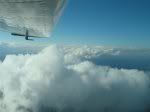 We had a good tailwind at altitude, and with smooth air, I kept cruise power for the descent. I don't remember what our true airspeed was, but the GPS recorded a maximum ground speed of 163 knots.
We had a good tailwind at altitude, and with smooth air, I kept cruise power for the descent. I don't remember what our true airspeed was, but the GPS recorded a maximum ground speed of 163 knots.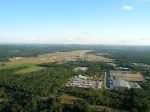 The airshow had wrapped up by the time we arrived home, but the field was still closed, so we practiced a few holds over the Chester VOR until the tower called us with instructions to enter the pattern. We touched down almost exactly two hours from the time we departed Lancaster, and about 11 hours after we left that morning.
The airshow had wrapped up by the time we arrived home, but the field was still closed, so we practiced a few holds over the Chester VOR until the tower called us with instructions to enter the pattern. We touched down almost exactly two hours from the time we departed Lancaster, and about 11 hours after we left that morning.


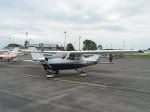
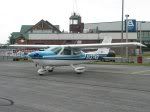
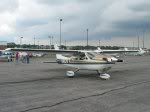

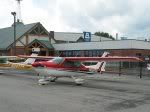
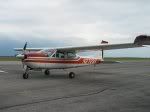
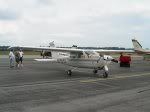
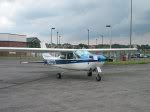

Great pics. Have you flown any of the various 177 models? I understand performance and handling improved dramatically over the years...the original 177 has a reputation as a bit of a lead sled that is somewhat squirrilly at low speed. Of course, that's in comparison to the 172, which the 177 was originally meant to replace.
Great pictures and write-up Scott! How did YB behave at 11,500?
Good read, Scott! Nice pictures, too!